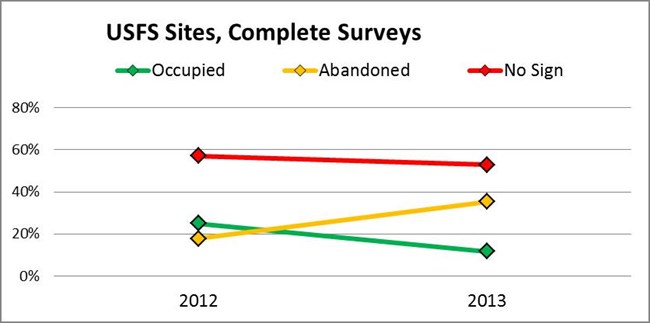
NPS photo by John Wegman Program Overview and Results of the 2013 Field SeasonThis was our 4th full year of the Olympic Marmot Monitoring Program, and the second year adding lands on Olympic National Forest. With the addition of USFS lands the program now encompasses the entire range of the species – pretty sobering. In 2013 we had 87 volunteers in 31 groups participate in the program; a total of 3440 volunteer hours were donated. Volunteer training was held on four Wednesdays in the months of August and September. Following training, surveyors spent from 1-8 days in a variety of areas of the Park and Forest, ranging from the front-country on Hurricane Hill to deep in the park near LaCrosse Pass. Volunteer surveyors in all regions traversed high-elevation meadows and rock-fields looking for and documenting sign of marmots and marmot burrows.

NPS 
Of the units that were completely surveyed in the core clusters in the Park in 2013, 52% were found to be occupied by marmots, 25% were abandoned (surveyors saw past but not recent sign of marmot use) and 23% had no sign of marmots. The rate of occupancy has varied between 53 and 48 % during the 4 years of the survey, and appears to be stable.

USFS Sites: Unlike the survey units in the park, the USFS survey units were not ground-truthed prior to the 2012 survey season. Ground-truthing occurred throughout the 2012 and 2013 season. Of the 46 survey units identified on USFS lands, volunteers were able to completely survey 17, partially survey 8, and unable to survey 21. The reasons for the incomplete or lack of survey varied, ranging from unsuitable habitat, too steep, or not enough time to get to all the units in the allotted time frame. Of the 17 units that were completely surveyed, only 12% (2) were occupied by marmots in 2013. As these survey areas are continuing to be refined, these data should be viewed with caution. Conclusions and Plans for 2014 Although it is too early to do any statistical analyses, there is enough data to eyeball some trends. Based on 4 years of surveying in the clusters that make up the program core, the occupancy rate of the population appears to be stable. Whether the trend is the same in all areas of the park needs further examination. We plan to continue the program in 2014 - that will make 5 years of monitoring. Following the 2014 season we hope to be able to get some help and perform statistical analyses of the data set. After 3 years in a row of above average late season snow pack, 2013 was a "normal "snow year, and 2014 is shaping up to be below normal. It will be interesting to see of the raw occupancy of marmot habitat remains constant into 2014. Acknowledgements: In 2013 this project was supported by a continuing grant from Washington's National Park Fund and funding from the U.S.F.S, Olympic National Forest. Training space was provided by Peninsula College. This whole endeavor would not have been possible without the hard work of the volunteer citizen scientists! 
Olympic Marmots
Learn more about the Olympic Marmot. 
Marmot Monitoring Volunteers
Teams of volunteers hike to locations within Olympic National Park to record up-to-date information about the Olympic Marmot. 
Marmot Research, Reports, and Links
Learn more about the research on Olympic Marmots. |
Last updated: July 18, 2024
